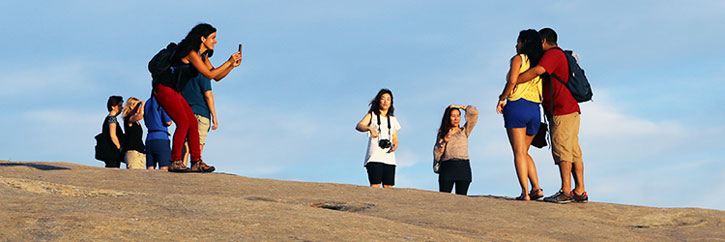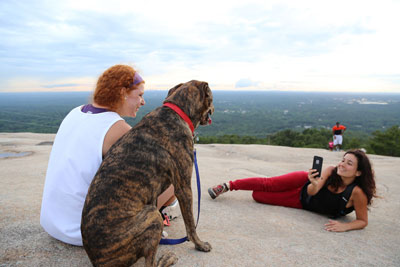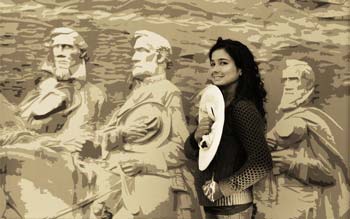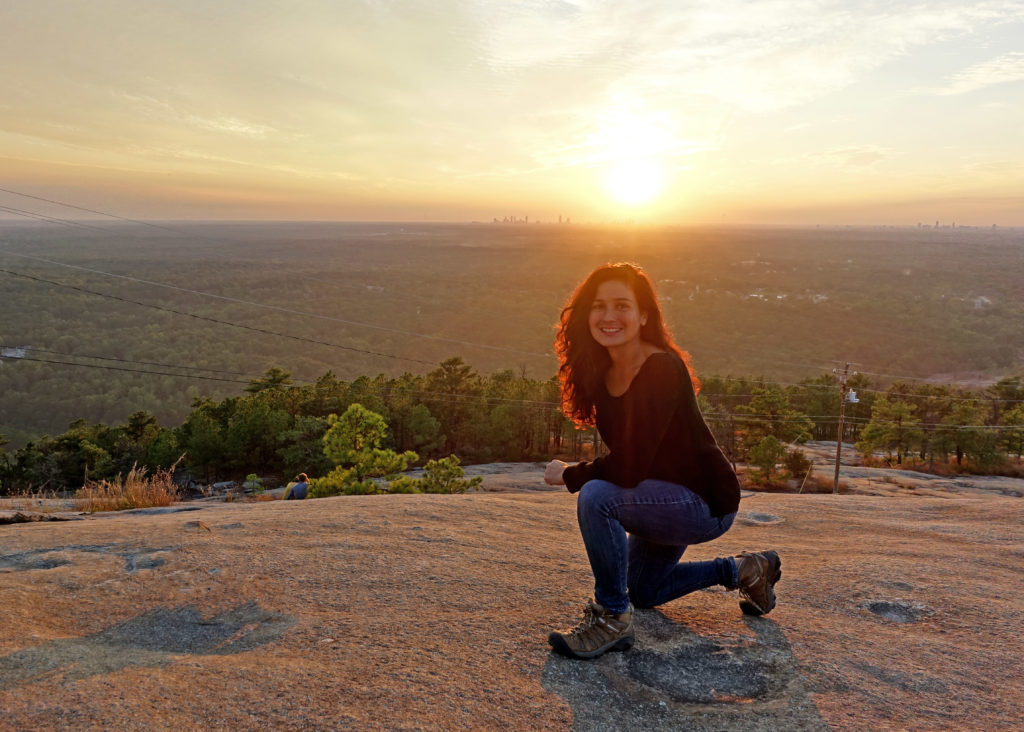"Let freedom ring from Stone Mountain of Georgia!"
— Martin Luther King, Jr.

Several years ago I moved back to Atlanta from New York, and found myself climbing Stone Mountain an awful lot for exercise and head-and-heart-clearing goodness. In true Southern Gothic style, I was called back home to Atlanta after my dad had died and became a caregiver to family members overnight. Not long after moving back to Atlanta I set up shop as a freelance book publicist and consultant and my older sister passed away in March 2010. I actually grew up in Stone Mountain and never would've imagined in a million years that walking up and down this rock, practically in my backyard, would figure into my healing from a quick succession of losses and life changes. What amazed me most upon my return to the mountain itself after so many years away, were all of the people I began meeting there from all over the world. It certainly wasn’t this diverse when I was younger, so I was truly absolutely moved by what appeared to be the mountain’s transformation from the infamous 20th Century rebirth place of the Ku Klux Klan 107 years ago into such a stunning ethnic mosaic of so many new faces. I had definitely experienced America's wondrous melting pot in New York but was in complete awe that the "freedom ringing from Stone Mountain of Georgia" that Dr. Martin Luther King, Jr. urged in his eternally powerful 1963 "I Have A Dream" speech was quite possibly being illustrated by all of these people of so many spiritual faiths and cultures and hailing from countries such as Ethiopia, Mexico, Colombia, Somalia, India, Pakistan, Nepal, Ghana, Guatemala, Vietnam, Cambodia, Israel, Saudi Arabia, Haiti, Afghanistan, Iran, France, Japan, Guyana, Venezuela, Kenya, Moldova, Kazakhstan, Bangladesh, England, South Sudan, refugees from Myanmar that had been living for years at a camp in Thailand, a young man of Mexican and Palestinian descent, and scores of fascinating Americans of all walks of life—and still so many more!
 Increasingly, I felt an urgent desire, even a responsibility, to show everyone what I was seeing — so much beautiful diversity constantly converging and flourishing upon this marvelous granite outcropping in the South, a monadnock that I have unfortunately been reminded in recent years is still emblematic of institutionalized racism at its worst. When it came time to build a website as my final project for the web design certification program I was enrolled in at Emory University back in 2014, I set about creating a digital experience of what I believed to be the mountain's inspiring transformation from a former bastion of white supremacy into a mountain that today bustles with such a rich variety of people and is now more than ever so ripe for reinterpretation and discovery but held within a state-owned and privately operated theme park. I hoped such a website, which is fully responsive and incorporates the latest HTML5 and CSS3 standards, would raise awareness of other cultures, encourage more dialogue among people, and wake many up to the need to protect our public parks and spaces environmentally and ideologically. The process has often forced me to look deeper into painful aspects of the mountain's history that many may find uncomfortable (usually it's self-appointed patrician protectors of the city's buildings and institutions that are confused that I am not here to blindly promote a landmark I care about), but I feel the truth will ultimately help heal the mountain. Today I continue to hope, despite recent challenges by those enamored with myths of the Confederacy, that this website will contribute to helping set this natural wonder free from the Confederate brand that has so long branded Stone Mountain at the exclusion of so much other valuable history related to the mountain and the area long before and after the Second Era Klan's rebirth. Dr. Martin Luther King, Jr.'s wish for freedom to ring from Stone Mountain (and from all of the mountains and molehills he mentions in his eternally powerful speech) should be of utmost consideration when it comes to every decision made related to Stone Mountain Park. And Stone Mountain, having once been the headquarters for a hate group, bears a special responsibility to uphold civil and human rights, especially after opening the doors of its theme park on the centennial of Abraham Lincoln's assassination, April 14, 1965, as a direct affront to the Civil Rights Movement.
Increasingly, I felt an urgent desire, even a responsibility, to show everyone what I was seeing — so much beautiful diversity constantly converging and flourishing upon this marvelous granite outcropping in the South, a monadnock that I have unfortunately been reminded in recent years is still emblematic of institutionalized racism at its worst. When it came time to build a website as my final project for the web design certification program I was enrolled in at Emory University back in 2014, I set about creating a digital experience of what I believed to be the mountain's inspiring transformation from a former bastion of white supremacy into a mountain that today bustles with such a rich variety of people and is now more than ever so ripe for reinterpretation and discovery but held within a state-owned and privately operated theme park. I hoped such a website, which is fully responsive and incorporates the latest HTML5 and CSS3 standards, would raise awareness of other cultures, encourage more dialogue among people, and wake many up to the need to protect our public parks and spaces environmentally and ideologically. The process has often forced me to look deeper into painful aspects of the mountain's history that many may find uncomfortable (usually it's self-appointed patrician protectors of the city's buildings and institutions that are confused that I am not here to blindly promote a landmark I care about), but I feel the truth will ultimately help heal the mountain. Today I continue to hope, despite recent challenges by those enamored with myths of the Confederacy, that this website will contribute to helping set this natural wonder free from the Confederate brand that has so long branded Stone Mountain at the exclusion of so much other valuable history related to the mountain and the area long before and after the Second Era Klan's rebirth. Dr. Martin Luther King, Jr.'s wish for freedom to ring from Stone Mountain (and from all of the mountains and molehills he mentions in his eternally powerful speech) should be of utmost consideration when it comes to every decision made related to Stone Mountain Park. And Stone Mountain, having once been the headquarters for a hate group, bears a special responsibility to uphold civil and human rights, especially after opening the doors of its theme park on the centennial of Abraham Lincoln's assassination, April 14, 1965, as a direct affront to the Civil Rights Movement.
When I first began posting to I Am The Mountain, my intention was to limit my focus to just the mountain itself, primarily the walk-up trail on its west face, and to give especial attention to the great variety of people sharing common ground there on any given day. I wanted to explore just how Stone Mountain is being used today by locals, regulars, nature lovers, and, of course, tourists from all over the world as contrasted with its difficult 20th Century history when it was appropriated by a hate group for nearly half a century. But, understandably, the more invested I have become in understanding the physical mountain’s role today, it’s been harder to ignore the park’s history and practices, especially as it ties into Atlanta's history, and the white supremacist implications of the Confederate carving on Stone Mountain’s north face. Occasionally I meet people that sadly still live in the past. It’s been more difficult than ever to reconcile the strange and sad fate of this gift of nature having been relegated to the epicenter of a theme park dedicated to upholding the myths of a triumphant Confederacy. A beautiful cross-section of humanity does indeed take to the mountain every day, and while people transform its spirit in theory, transformation must be in practice at an institutional level for the Stone Mountain (or any place) to ever transcend it’s darkest chapters in its history that continue to be perpetuated.
WHAT'S IN A NAME?
The first seven letters of I AM THE MOUNTAIN spell I AM THEM. I am them: I am each and every person who has generously participated in this project about the diverse people of the world that climb Stone Mountain, just as they are me, and we are ultimately one.
 By the lottery of birth, I grew up in Stone Mountain, GA, and always believed myself to be half Mexican, a quarter English, and a quarter Irish until I took an Ancestry.com DNA test in April 2015 (and then another through 23andMe later on to compare the results). I felt that if I was asking so many people to talk about race at the mountain, then it was only fair to be open with my ethnic background, especially as I believe we are all much more connected than we imagine.
By the lottery of birth, I grew up in Stone Mountain, GA, and always believed myself to be half Mexican, a quarter English, and a quarter Irish until I took an Ancestry.com DNA test in April 2015 (and then another through 23andMe later on to compare the results). I felt that if I was asking so many people to talk about race at the mountain, then it was only fair to be open with my ethnic background, especially as I believe we are all much more connected than we imagine.
Growing up in the shadow of a Confederate monument at a time when the Klan was still active in Stone Mountain, as terrifying news of the Atlanta Child Murders filled the air waves for years, clearly impacted me and left no question as to which side of history I want be. When I was 10, my fifth grade teacher was out on maternity leave, and our substitute teacher chose to devote weeks to teaching us about the Civil Rights Movement, which I consider an enormous blessing. As an 11 year-old, I remember religiously watching those first episodes of "Oprah" after school, and she'd only been on the air for five or so months when she covered the Klan rally in Forsyth County, GA in 1987. I admired people who fiercely spoke out against injustice then, and I admire them now and count myself among them. The forces that keep racism institutionalized and have allowed the narratives of so many American cities to be dominated by tired Confederate symbols (and war history as a whole)—at the exclusion of so many other important parts of America's story—greatly implicates politicians and lawmakers.
I received a B.A. in English from the University of Georgia, and while in Athens worked as a dishwasher, waitress, newspaper correspondent, a hotel concierge, and as a manager of a Mexican restaurant. Ten days before the turn of the 21st Century, I bought a one-way ticket to New York on AirTran (now defunct) for $89, and with $400 and a suitcase to my name, hit the streets of New York, got my first job out of college as a book publicist at a major book publisher, and lived in Brooklyn both before and after the tragedy of September 11, 2001. When I'm not working, I enjoy reading, traveling (I love our national parks!), photography, birdwatching, sometimes updating a basic personal website, and hiking. I take my coffee bold, love plain sparkling water, am a formidable Scrabble player, have two feline overlords, and can parallel park like nobody's business. When I can't afford to travel, I just travel in place and back in time, including researching history and genealogy — and walking up and down the mountain. Yes, I climb Stone Mountain a lot, but, contrary to popular belief, I am not there every day and do not live in a cave up up there like a Zen hermit. I hike other mountains in Georgia, such as Blood Mountain and Yonah Mountain—and in other U.S. states! I scaled Half Dome in Yosemite National Park in 2015 and traversed the Southern Presidential Peaks in the White Mountains of New Hampshire in 2016 and summited Mt. St. Helens with a group in the summer of 2018.



